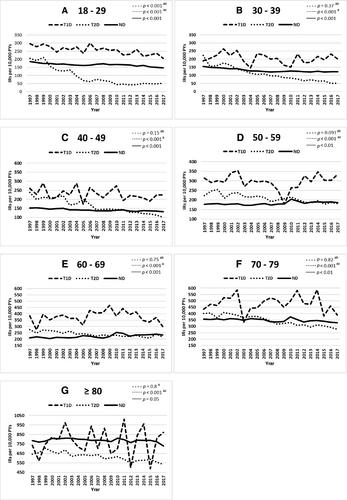Mohamad I Nasser, Annika Vestergaard Kvist, Peter Vestergaard, Richard Eastell, Andrea M Burden, Morten Frost
{"title":"1型和2型糖尿病的性别和年龄组骨折发生率趋势","authors":"Mohamad I Nasser, Annika Vestergaard Kvist, Peter Vestergaard, Richard Eastell, Andrea M Burden, Morten Frost","doi":"10.1002/jbm4.10836","DOIUrl":null,"url":null,"abstract":"<p>The incidence of major osteoporotic fractures has declined in men and women in Western countries over the last two decades. Although fracture risk is higher in persons with diabetes mellitus, trends of fractures remain unknown in men and women with diabetes. We investigated the trends in fracture incidence rates (IRs) in men and women with type 1 diabetes mellitus (T1D) and type 2 diabetes mellitus (T2D) in Denmark between 1997 and 2017. We identified men and women aged 18+ years who sustained a fracture (excluding skull and facial fractures) between 1997 and 2017 using the Danish National Patient Registry. We calculated sex-specific IRs of fractures per 10,000 person-years separately in persons with T1D, T2D, or without diabetes. Furthermore, we compared median IRs of the first 5 years (1997–2002) to the median IRs of the last 5 years (2012–2017). We identified 1,235,628 persons with fractures including 4863 (43.6% women) with T1D, 65,366 (57.5% women) with T2D, and 1,165,399 (54.1% women) without diabetes. The median IRs of fractures declined 20.2%, 19.9%, and 7.8% in men with T1D, T2D, and without diabetes, respectively (<i>p</i>-trend <0.05). The median IRs decreased 6.4% in women with T1D (<i>p</i>-trend = 0.35) and 25.6% in women with T2D (<i>p</i>-trend <0.05) but increased 2.3% in women without diabetes (<i>p</i>-trend = 0.08). Fracture IRs decreased in men with both diabetes types and only in women with T2D, highlighting the need for further attention behind the stable trend observed in women with T1D. © 2023 The Authors. <i>JBMR Plus</i> published by Wiley Periodicals LLC on behalf of American Society for Bone and Mineral Research.</p>","PeriodicalId":14611,"journal":{"name":"JBMR Plus","volume":"7 11","pages":""},"PeriodicalIF":2.4000,"publicationDate":"2023-10-27","publicationTypes":"Journal Article","fieldsOfStudy":null,"isOpenAccess":false,"openAccessPdf":"https://asbmr.onlinelibrary.wiley.com/doi/epdf/10.1002/jbm4.10836","citationCount":"0","resultStr":"{\"title\":\"Sex- and Age Group-Specific Fracture Incidence Rates Trends for Type 1 and 2 Diabetes Mellitus\",\"authors\":\"Mohamad I Nasser, Annika Vestergaard Kvist, Peter Vestergaard, Richard Eastell, Andrea M Burden, Morten Frost\",\"doi\":\"10.1002/jbm4.10836\",\"DOIUrl\":null,\"url\":null,\"abstract\":\"<p>The incidence of major osteoporotic fractures has declined in men and women in Western countries over the last two decades. Although fracture risk is higher in persons with diabetes mellitus, trends of fractures remain unknown in men and women with diabetes. We investigated the trends in fracture incidence rates (IRs) in men and women with type 1 diabetes mellitus (T1D) and type 2 diabetes mellitus (T2D) in Denmark between 1997 and 2017. We identified men and women aged 18+ years who sustained a fracture (excluding skull and facial fractures) between 1997 and 2017 using the Danish National Patient Registry. We calculated sex-specific IRs of fractures per 10,000 person-years separately in persons with T1D, T2D, or without diabetes. Furthermore, we compared median IRs of the first 5 years (1997–2002) to the median IRs of the last 5 years (2012–2017). We identified 1,235,628 persons with fractures including 4863 (43.6% women) with T1D, 65,366 (57.5% women) with T2D, and 1,165,399 (54.1% women) without diabetes. The median IRs of fractures declined 20.2%, 19.9%, and 7.8% in men with T1D, T2D, and without diabetes, respectively (<i>p</i>-trend <0.05). The median IRs decreased 6.4% in women with T1D (<i>p</i>-trend = 0.35) and 25.6% in women with T2D (<i>p</i>-trend <0.05) but increased 2.3% in women without diabetes (<i>p</i>-trend = 0.08). Fracture IRs decreased in men with both diabetes types and only in women with T2D, highlighting the need for further attention behind the stable trend observed in women with T1D. © 2023 The Authors. <i>JBMR Plus</i> published by Wiley Periodicals LLC on behalf of American Society for Bone and Mineral Research.</p>\",\"PeriodicalId\":14611,\"journal\":{\"name\":\"JBMR Plus\",\"volume\":\"7 11\",\"pages\":\"\"},\"PeriodicalIF\":2.4000,\"publicationDate\":\"2023-10-27\",\"publicationTypes\":\"Journal Article\",\"fieldsOfStudy\":null,\"isOpenAccess\":false,\"openAccessPdf\":\"https://asbmr.onlinelibrary.wiley.com/doi/epdf/10.1002/jbm4.10836\",\"citationCount\":\"0\",\"resultStr\":null,\"platform\":\"Semanticscholar\",\"paperid\":null,\"PeriodicalName\":\"JBMR Plus\",\"FirstCategoryId\":\"1085\",\"ListUrlMain\":\"https://onlinelibrary.wiley.com/doi/10.1002/jbm4.10836\",\"RegionNum\":0,\"RegionCategory\":null,\"ArticlePicture\":[],\"TitleCN\":null,\"AbstractTextCN\":null,\"PMCID\":null,\"EPubDate\":\"\",\"PubModel\":\"\",\"JCR\":\"Q2\",\"JCRName\":\"ENDOCRINOLOGY & METABOLISM\",\"Score\":null,\"Total\":0}","platform":"Semanticscholar","paperid":null,"PeriodicalName":"JBMR Plus","FirstCategoryId":"1085","ListUrlMain":"https://onlinelibrary.wiley.com/doi/10.1002/jbm4.10836","RegionNum":0,"RegionCategory":null,"ArticlePicture":[],"TitleCN":null,"AbstractTextCN":null,"PMCID":null,"EPubDate":"","PubModel":"","JCR":"Q2","JCRName":"ENDOCRINOLOGY & METABOLISM","Score":null,"Total":0}
引用次数: 0


 求助内容:
求助内容: 应助结果提醒方式:
应助结果提醒方式:


